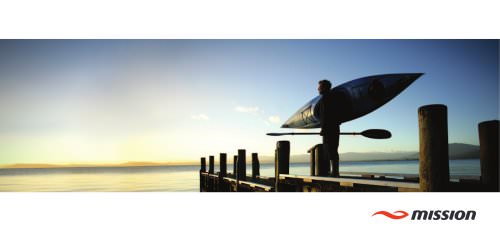
Catalog excerpts

CONGRATULATIONS! YOU HAVE CHOSEN A MISSION KAYAK THAT HAS BEEN CAREFULLY DESIGNED AND CRAFTED WITH YOUR NEEDS IN MIND. YOU ARE NOW PART OF A GROWING FAMILY OF MISSION KAYAK OWNERS. VISIT US AT WWW.MISSIONKAYAKING.COM
Open the catalog to page 3
GO ON A MISSION – EXPLORE NEIGHBOURHOOD STREAMS. CATCH SOME WAVES. SPEND A FEW DAYS ON THE RIVER AND CAMP IN THE MIDDLE OF NOWHERE, DISCOVER NEW OCEANS. ENJOY THE JOURNEY AND REACH THE DESTINATION.
Open the catalog to page 5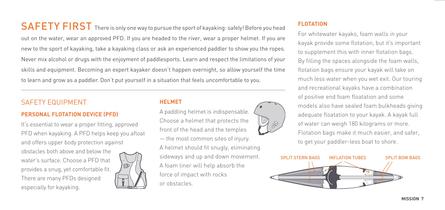
SAFETY FIRST There is only one way to pursue the sport of kayaking: safely! Before you head out on the water, wear an approved PFD. If you are headed to the river, wear a proper helmet. If you are new to the sport of kayaking, take a kayaking class or ask an experienced paddler to show you the ropes. Never mix alcohol or drugs with the enjoyment of paddlesports. Learn and respect the limitations of your skills and equipment. Becoming an expert kayaker doesn’t happen overnight, so allow yourself the time to learn and grow as a paddler. Don’t put yourself in a situation that feels...
Open the catalog to page 7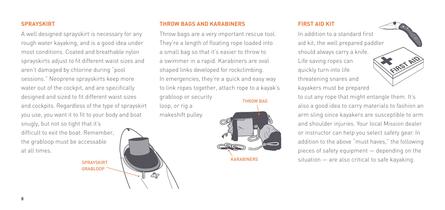
SPRAYSKIRT THROW BAGS AND KARABINERS FIRST AID KIT A well designed sprayskirt is necessary for any rough water kayaking, and is a good idea under most conditions. Coated and breathable nylon sprayskirts adjust to t different waist sizes and aren’t damaged by chlorine during “pool sessions.” Neoprene sprayskirts keep more water out of the cockpit, and are specically designed and sized to t different waist sizes and cockpits. Regardless of the type of sprayskirt you use, you want it to t to your body and boat snugly, but not so tight that it’s difcult to exit the boat. Remember, the grabloop...
Open the catalog to page 8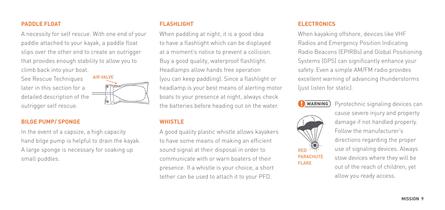
PADDLE FLOAT FLASHLIGHT ELECTRONICS A necessity for self rescue. With one end of your paddle attached to your kayak, a paddle oat slips over the other end to create an outrigger that provides enough stability to allow you to climb back into your boat. AIR VALVE See Rescue Techniques later in this section for a detailed description of the outrigger self rescue. When paddling at night, it is a good idea to have a ashlight which can be displayed at a moment’s notice to prevent a collision. Buy a good quality, waterproof ashlight. Headlamps allow hands free operation (you can keep paddling)....
Open the catalog to page 9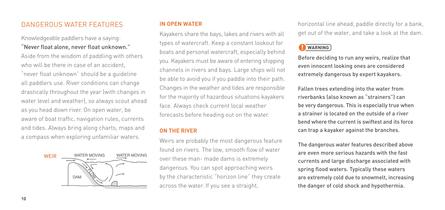
DANGEROUS WATER FEATURES Knowledgeable paddlers have a saying: “Never oat alone, never oat unknown.” Aside from the wisdom of paddling with others who will be there in case of an accident, “never oat unknown” should be a guideline all paddlers use. River conditions can change drastically throughout the year (with changes in water level and weather), so always scout ahead as you head down river. On open water, be aware of boat trafc, navigation rules, currents and tides. Always bring along charts, maps and a compass when exploring unfamiliar waters. WEIR 10 IN OPEN WATER Kayakers share the...
Open the catalog to page 10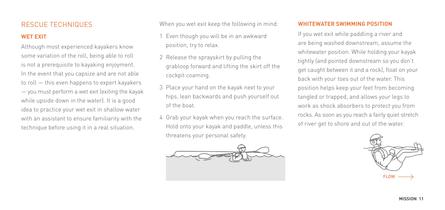
RESCUE TECHNIQUES When you wet exit keep the following in mind: WHITEWATER SWIMMING POSITION WET EXIT 1 Even though you will be in an awkward position, try to relax. If you wet exit while paddling a river and are being washed downstream, assume the whitewater position. While holding your kayak tightly (and pointed downstream so you don’t get caught between it and a rock), oat on your back with your toes out of the water. This position helps keep your feet from becoming tangled or trapped, and allows your legs to work as shock absorbers to protect you from rocks. As soon as you reach a...
Open the catalog to page 11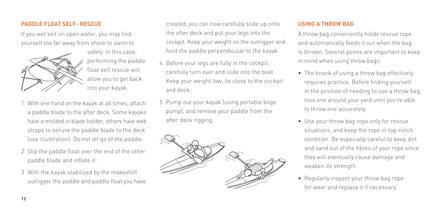
PADDLE FLOAT SELF- RESCUE created, you can now carefully slide up onto the after deck and put your legs into the cockpit. Keep your weight on the outrigger and hold the paddle perpendicular to the kayak. If you wet exit on open water, you may nd yourself too far away from shore to swim to safety. In this case, performing the paddle oat self rescue will allow you to get back into your kayak. 4 Before your legs are fully in the cockpit, carefully turn over and slide into the boat. Keep your weight low, lie close to the cockpit and deck. 1 With one hand on the kayak at all times, attach a...
Open the catalog to page 12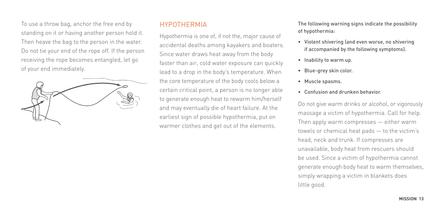
To use a throw bag, anchor the free end by standing on it or having another person hold it. Then heave the bag to the person in the water. Do not tie your end of the rope off. If the person receiving the rope becomes entangled, let go of your end immediately. HYPOTHERMIA Hypothermia is one of, if not the, major cause of accidental deaths among kayakers and boaters. Since water draws heat away from the body faster than air, cold water exposure can quickly lead to a drop in the body’s temperature. When the core temperature of the body cools below a certain critical point, a person is no...
Open the catalog to page 13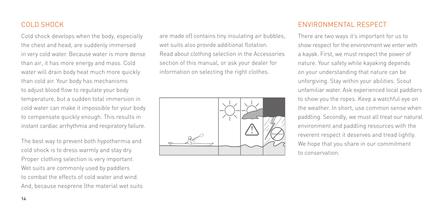
COLD SHOCK Cold shock develops when the body, especially the chest and head, are suddenly immersed in very cold water. Because water is more dense than air, it has more energy and mass. Cold water will drain body heat much more quickly than cold air. Your body has mechanisms to adjust blood ow to regulate your body temperature, but a sudden total immersion in cold water can make it impossible for your body to compensate quickly enough. This results in instant cardiac arrhythmia and respiratory failure. ENVIRONMENTAL RESPECT are made of) contains tiny insulating air bubbles, wet suits also...
Open the catalog to page 14
ACCESSORIES PADDLES Your paddle has a big impact on how enjoyable paddling will be. One that’s poorly made and doesn’t t you can make for a miserable day on the water, while a high quality, well selected paddle is a real delight. Personal preferences denitely gure into your selection. How does it feel? How fast are you going to paddle? How far? These are all important questions to consider and discuss with your dealer. If you can, try out several different styles and lengths to get a feel for what’s most comfortable. When choosing a paddle keep these important characteristics in mind....
Open the catalog to page 15
SPRAYSKIRTS CLOTHING STORAGE GEAR Sprayskirts are usually made of either nylon, breathable nylon or neoprene. Nylon is cooler than neoprene, but neoprene’s better at keeping water out of your boat. Having a sprayskirt that properly ts you and your boat is critical, It’s also important to protect your feet, head and hands from the elements. Neoprene booties keep your feet warm and provide protection from rocks. A wool pile or polypropylene cap prevents heat loss through the head. And neoprene or wool gloves or paddle mitts (which are attached to your paddle and allow easy hand entry/exit)...
Open the catalog to page 16All Mission Kayaking catalogs and brochures
-
Glide390
2 Pages
-
Beach
2 Pages
-
SWITCH WINGMAN
2 Pages
-
XSTREAM 420 CATCH 420
2 Pages
-
KOTARE CATCH 390
2 Pages
-
CATCH 290
1 Pages
-
ACCESS 400 LINE 400
2 Pages
-
ACCESS 280 LINE 280
2 Pages
-
ACCESSOIRIES BROCHURE
16 Pages
-
FISHING KAYAKS BROCHURE
3 Pages
-
OCEAN KAYAKS BROCHURE
2 Pages
-
LAKE KAYAKS BROCHURE
3 Pages
-
RIVER KAYAKS BROCHURE
2 Pages
Archived catalogs
-
BEACH KAYAK BROCHURE
3 Pages

